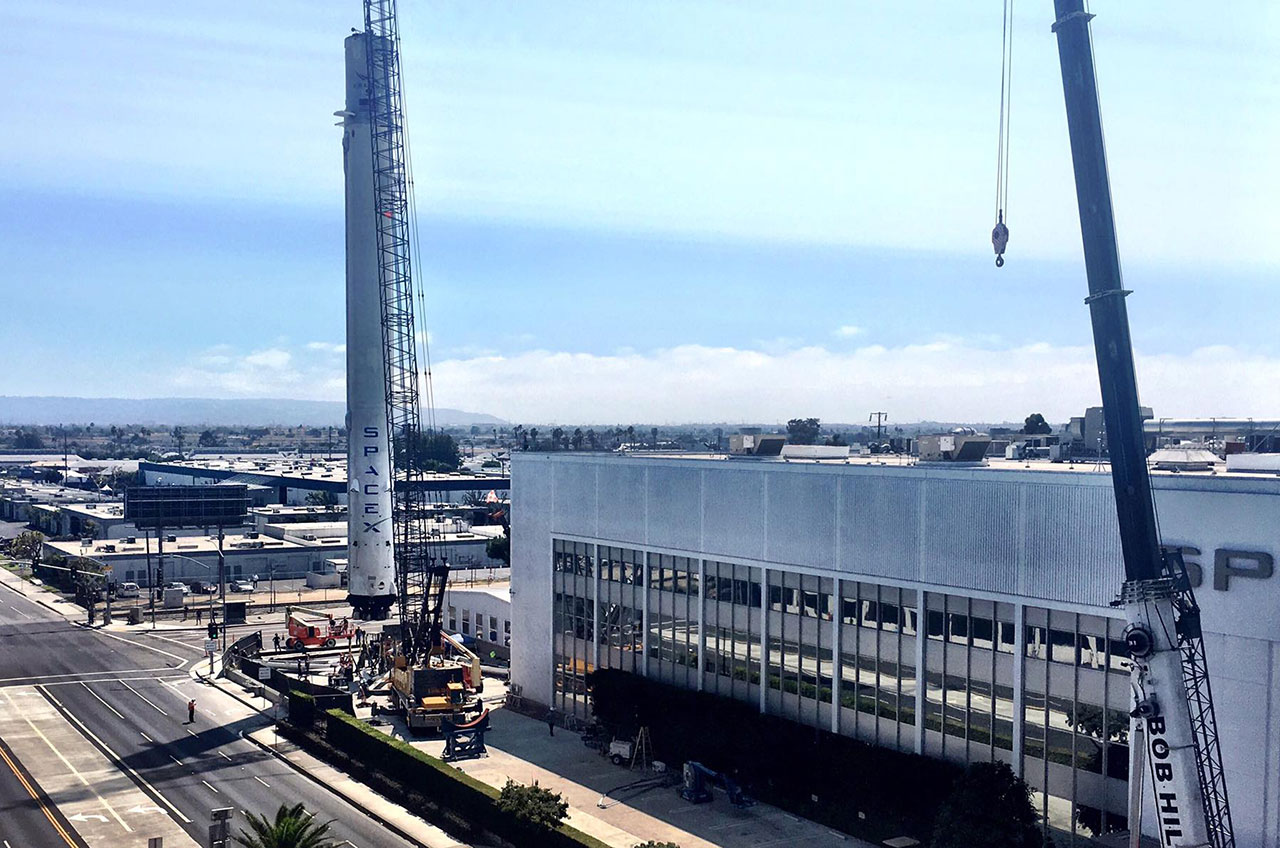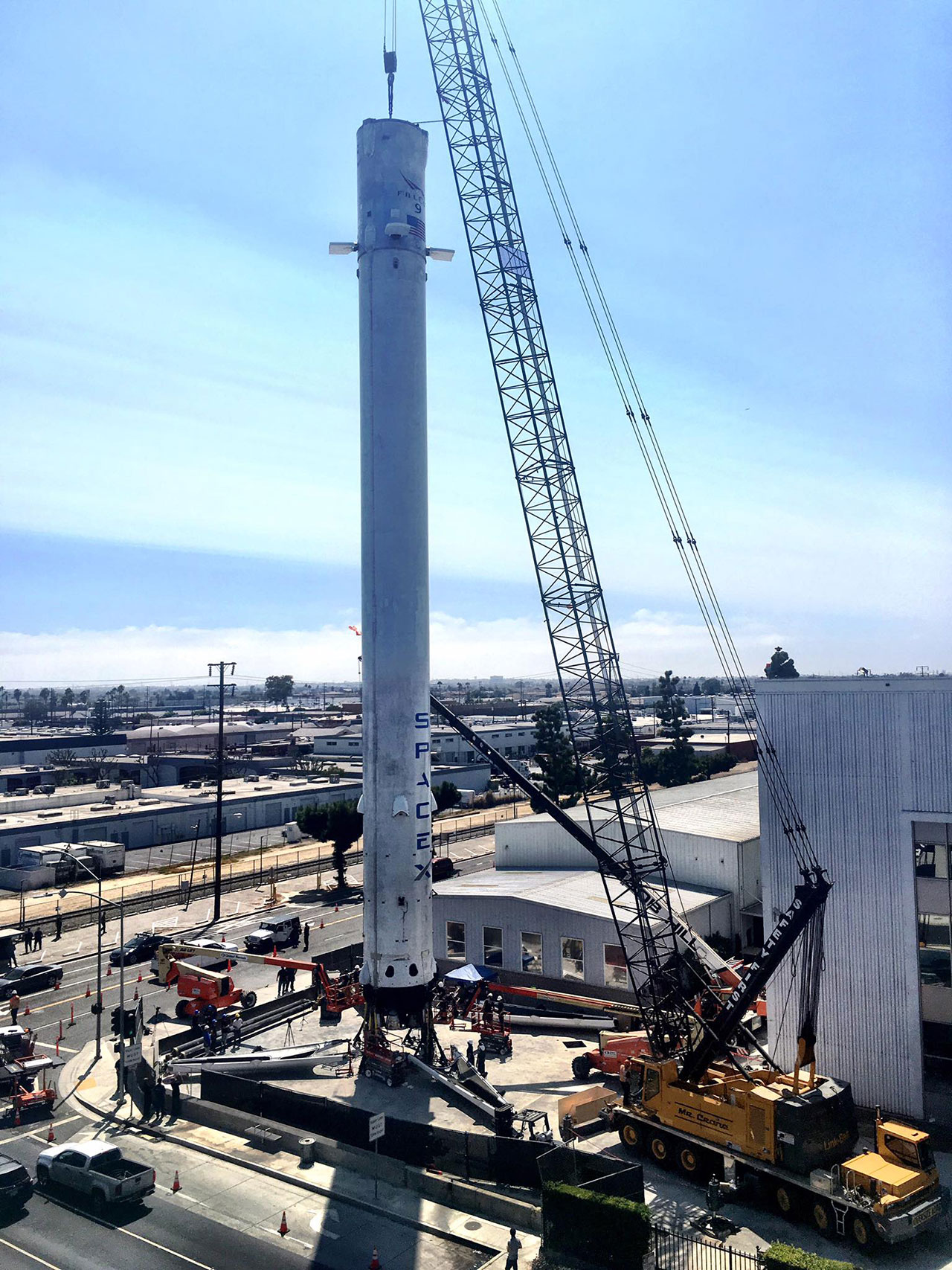SpaceX Lands Historic Recovered Falcon 9 Rocket Stage on Display

SpaceX's first recovered rocket stage has landed on display outside of the company's California headquarters eight months after it made history.
The nine engine booster, which on Dec. 21, 2015, became the world's first rocket stage to help launch a payload into Earth orbit and then fly back and touch down near where it had lifted off, is now a 15-story-tall monument at SpaceX's offices and manufacturing facility in Hawthorne, California.
The Falcon 9 stage was erected on Saturday and Sunday (Aug. 20-21) at the intersection of Jack Northrop Ave. and Crenshaw Blvd., at the southeast corner of SpaceX HQ. It had previously been parked, lying horizontally a few blocks away, since being delivered from NASA's Kennedy Space Center in Florida in June. [Watch First 5 SpaceX Rocket Landings in This Epic Video]
The 165-foot-tall (50 m) first stage, part of the 20th Falcon 9 flown, is displayed in a similar configuration to the way it looked when it descended to SpaceX's Landing Zone (LZ-1) at Cape Canaveral Air Force Station. The stage, which launched with 11 Orbcomm communications satellites, has its grid fins extended and landing legs deployed.
The soot deposited on the stage's body during its historic landing has been mostly cleaned off, its logos have been repainted and most, if not all of its nine Merlin engines look to have been replaced by spent, stripped down versions. Otherwise, the vehicle appears to have been preserved as an artifact.
"It's kind of unique. It's the first one we brought back," Elon Musk, SpaceX's CEO and chief technology officer, stated soon after the stage landed in December 2015.

Since that first recovery, SpaceX has successfully landed five more Falcon 9 first stages — one at LZ-1 and four on its autonomous spaceport drone ship, the latter an ocean-going platform used for when the Falcon 9's launch profile does not leave enough fuel for the first stage to fly back to the coast.
Get the Space.com Newsletter
Breaking space news, the latest updates on rocket launches, skywatching events and more!
SpaceX has been working to perfect the landings so that the recovered stages can be reused, lowering the costs of putting payloads into orbit. Before shipping it to Hawthorne for its display, the Orbcomm stage (F9-021) was erected at Complex 40 in Cape Canaveral for a successful test fire on Jan. 15.
Another Falcon 9 first stage from a satellite launch in May has been delivered to SpaceX's test facilities in McGregor, Texas, for a series of on-going static firings. The company has said it may be ready to re-fly a recovered stage for the first time later this year.
SpaceX needed the Federal Aviation Administration (FAA) to approve its plan to erect the first recovered stage due to the display's height and its location adjacent to Hawthorne Municipal Airport. In March, the FAA concluded found "that the structure would have no substantial adverse effect" to the use of the surrounding airspace.
The agency did however, require red lights be added to the Falcon stage's display within five days of it going vertical to alert approaching aircraft.
The stage, which can be seen from the surrounding area, is not the only artifact displayed at SpaceX's headquarters. Although closed to the public, inside the facility, suspended from the ceiling, is SpaceX's first Dragon capsule, which in 2010 became the first private spacecraft to be recovered from Earth orbit.
See more photos of the SpaceX Falcon 9 first stage monument and watch a highlight video from its historic 2015 landing at collectSPACE.
Follow collectSPACE.com on Facebook and on Twitter at @collectSPACE. Copyright 2016 collectSPACE.com. All rights reserved.
Join our Space Forums to keep talking space on the latest missions, night sky and more! And if you have a news tip, correction or comment, let us know at: community@space.com.

Robert Pearlman is a space historian, journalist and the founder and editor of collectSPACE.com, a daily news publication and community devoted to space history with a particular focus on how and where space exploration intersects with pop culture. Pearlman is also a contributing writer for Space.com and co-author of "Space Stations: The Art, Science, and Reality of Working in Space” published by Smithsonian Books in 2018.In 2009, he was inducted into the U.S. Space Camp Hall of Fame in Huntsville, Alabama. In 2021, he was honored by the American Astronautical Society with the Ordway Award for Sustained Excellence in Spaceflight History. In 2023, the National Space Club Florida Committee recognized Pearlman with the Kolcum News and Communications Award for excellence in telling the space story along the Space Coast and throughout the world.

